

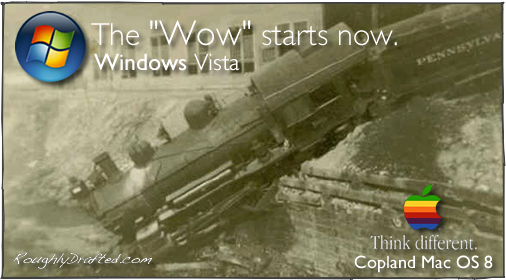
Apple’s announcement that finishing the iPhone would come at the cost of a delayed release of Mac OS X Leopard set off a flurry of bizarre responses from Apple detractors always on the lookout for ways to bulldoze the company's mountains into minor molehills.
Has Leopard fallen into a Copland-Vista Conundrum? Consider the actual events during Apple’s Copland and Microsoft’s Vista crisis periods and compare them to today’s delay of Leopard. The factors that held up both Copland and Vista simply don't apply to Leopard.
Between 1992 and 1998, Apple cranked out minimal updates to its Mac System 7 software, but could not seem to regain the rock solid stability of previous versions of the Mac operating system.
While the existing System 7 software tumbled downhill, Apple also failed to deliver its plans for the next generation Pink-Taligent projects between 1993-1995, and its Copland-Gershwin plans between 1994-1996.
Apple didn't face a delay in delivery; those project simply never materialized in anything close to a workable form. There was no real mystery involved in why Apple couldn't deliver on its plans. There were, in fact, good reasons why Pink and Copland were doomed to fail.
Lipstick for Pigs.
The original Mac System Software from the mid 80s had been designed only to run on a simple appliance computer. Pink and particularly Copland attempted to extend upon the Mac's simple appliance System Software with the “modern OS features” associated with Unix: multitasking, multiple users, and memory protection.
Sure it could be done, and Apple's engineers managed to devise plans to accomplish all those things; they just didn't make any practical sense, and resulted in increasingly complex software with new problems.
It was like adding another twenty stories to the Transamerica Pyramid. Given enough money it could be done, but it would be really ugly, an outrageous waste of resources, and it certainly wouldn't be the Pyramid any more.
Sure enough, the harder Apple worked to build a modern, next generation Mac operating system, the less it looked like the original Mac. The more Apple worked to maintain the Mac's original character, the less sophisticated it could hope to be.
Standing on the Shoulders of Unix.
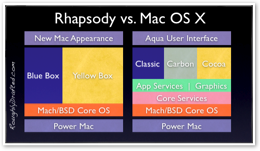 Apple really needed an entirely new foundation. With Mac OS X, the new underlying core OS was Unix, inherited from the NeXTSTEP software that had been refined in real world use years longer than Microsoft’s Windows.
Apple really needed an entirely new foundation. With Mac OS X, the new underlying core OS was Unix, inherited from the NeXTSTEP software that had been refined in real world use years longer than Microsoft’s Windows. It was much easier for Apple to retrofit the Mac look and its existing software--including QuickTime and other Apple assets--on top of this entirely new foundation than to shovel comparable foundation features under the edges of the crumbling old building of the Classic Mac OS.
Advancing the State of the Art.
In addition, Apple replaced a number of problematic structures with entirely clean and modern systems. One limiting factor in the original OS that had complicated the addition of Unix features was the Mac's QuickDraw graphics system.
While revolutionary in the mid 80s, it tied everything to a “non-reentrant” procedural model that erected barriers to multiple users, multiprocessing, memory protection, and process preemption.
In Mac OS X, Apple replaced the original Mac QuickDraw with Quartz, an entirely new drawing engine that shifted the burden of drawing the display from individual applications to the system. That paved the way for optimizing video and graphic effects by pushing drawing operations to a specialized video processor.
Modern, Clean, and Open.
Another major, overall architectural change in Mac OS X was the use of efficient, object oriented frameworks that handled much of the tedious work required to build applications. In modern Mac OS X development, applications that take advantage of these frameworks benefit from system-wide updates.
The only real similarity between the 1984 Mac and the 2007 Mac is the parallel motivation that fueled Apple's engineers to build highly integrated hardware and software products that are simple, powerful, and elegant.
With the new Unix foundation of Mac OS X, Apple shares the same technology as the mainstream of open sourced development. Apple extensively shares with and borrows from BSD groups and the GNU/Linux projects. That makes Apple's OS technologies accessible, interoperable, and resilient to changes in the computing world.
That's a 180 degree change from the days of Copland. The ancient legacy baggage and proprietary problems that hung up Copland are not problems delaying Leopard.
A Similar Vista.
And what about Microsoft? Its early 80s copy of the Mac wasn't even shipping on PCs until 1990, and wasn't charitably comparable to the Mac until the end of 1995. Its 1991 Cairo plans petered on until around 1997 when the company finally stopped talking about them.
The company offered up a series of increasingly bad versions of DOS-based Windows that reached a QA anti-crescendo with Windows ME.
Then, six years after the original release of NT, Microsoft delivered a workable, professional version of NT as Windows 2000, and followed up a year later with Windows XP.
The 2001 release of XP, like Apple's 1991 System 7, offered the illusion of being a great product. Under the slick marketing however, both were ineffectual half steps that didn't offer much real advancement in technology. Both were also mired in legacy that would make further progress problematic.
More Pig Lipstick.
Just as System 7 used clever hacks to add color and the use of multiple programs to the original mid 80s Mac, Windows XP was a fresh coat of paint on top of technology anchored in the 90s world of DOS and LANManager.
Microsoft had spent the 90s developing a closed OS designed for IT managers to run within little enclaves of PC LANs. Trying to retrofit in support for insecure, open networks in Windows was as senseless as trying to cram Unix technology into System 7 or sprouting new floors on the Pyramid. Possible? Maybe. Practical? No.
 Unsurprisingly, after the release of XP Microsoft offered six years of nothing but service packs and bug fixes, most of which tried to patch up the security problems intrinsic to the closed and proprietary development that had stuffed over a decade of Windows legacy into XP, weighing it down from further advancement.
Unsurprisingly, after the release of XP Microsoft offered six years of nothing but service packs and bug fixes, most of which tried to patch up the security problems intrinsic to the closed and proprietary development that had stuffed over a decade of Windows legacy into XP, weighing it down from further advancement.NT as an OS.
The core OS of Windows XP was the NT kernel, a system Microsoft had developed on its own. It shared some similarities with VMS, thanks to its key architect Dave Cutler, who had come from VMS vendor DEC.
However, unlike the various flavors of Unix developed by AT&T, Sun, IBM, various universities, and maintained by open source developers working on different versions of BSD and later Linux, NT was only ever a secret project within Microsoft.
Nobody played with the code, experimented with parallel forks, or adapted it in new applications. There has been no open development of NT apart from some minor efforts to clone it.
Even Microsoft failed to maintain NT on multiple platforms as it originally intended. Efforts to create a loosely related WinCE platform have been an abysmal failure, leaving Microsoft with three major variants of NT: the common Intel x86 versions, the 64-bit version which sank along with Itanium, and the PowerPC version which runs the rather simple needs of the Xbox 360 game console.
The development of NT sat solely in the hands of a company that had never managed to ship its own OS before; it had only ever licensed Unix to resell as Xenix and then QDOS--a lookalike version of CP/M--to resell under the name MS-DOS.
Microsoft built everything it knew about software on top of MS-DOS, a clone of a clone of a simple shell from the 70s. That's hardly a powerful set of credentials for developing a rival to the industry standard Unix, but Microsoft tried to pull off NT anyway.
NT was long known as the contraction within doesN'T work. Microsoft also struggled long and hard to ship a version of NT for consumers, but was unable to prior to XP in 2001.
The company had to resort to ugly hacks to get legacy DOS apps such as games to run on NT. It also made compromises to the original design of NT, pushing user level subsystems, including graphics, into the kernel in order to improve system performance.
Microsoft’s Obscurity Security.
Having a closed, proprietary system enabled Microsoft to ignore security vulnerabilities, relying instead on ‘security through obscurity,’ the hope that if nobody knows where the flaws are, they can’t exploit them.
That turned out to be a tragic mistake as the number of internal vulnerabilities began to pass a Swiss Cheese level threshold. Windows PCs began falling over at regular intervals like thinly cut slices.
Windows is now so insecure that it simply makes no sense to expose a Windows PC to the open Internet without layers of firewall diapers, excessively strict behavior limits on the part of users, and third party security software constantly running in the background--which opens potential new risks itself.
Windows requires this constant intervention session because it simply has no control over its behavior. It’s addicted to infection, intoxicated by spam, and always moments from being face down in the gutter.
Vista has the same proprietary mess of kernel as its foundation: NT 6.0. NT has made only minor progress since it began at version 3, over a decade ago within an amateur operating system vendor.
Catching up to Quartz.
While bragging up Cairo in 1991 as a fantastical future of imagined advancements to the superior products that already existed, Bill Gates' company simply failed to deliver real products over the next decade, reselling DOS over and over instead, with an increasingly top-heavy layer of graphical Mac emulation above it.
Windows borrowed heavily from the Mac. As an early Mac developer, Microsoft had intimate knowledge of the Mac architecture, and transferred that into Windows.
For its graphics, Microsoft copied the original Mac's QuickDraw, calling its Windows version GDI. It was no straight port, because Windows had to accommodate the much poorer quality hardware and the random graphics support available on PCs, where pixels might not be consistently square like they were on the Mac.
 Windows XP graphics are therefore a lot like an extended, complex version of QuickDraw, the same system Apple worked to replace with the new Quartz engine back in 2001 when XP debuted.
Windows XP graphics are therefore a lot like an extended, complex version of QuickDraw, the same system Apple worked to replace with the new Quartz engine back in 2001 when XP debuted.With Vista, Microsoft had to figure out how to glue a new, modern graphic compositing system on top of its old Windows. Microsoft again had to look to Apple for ideas. It promised to add something like Mac OS X's 2001 Quartz, but couldn't actually ship it for another 6 years.
So now Vista has a modern graphics system in Avalon, the Windows Presentation Foundation. The difference is that unlike Mac OS X's Quartz, WPF is based not on the open PDF industry standard, but upon a proprietary model Microsoft is pushing called XPS. Instead of using the industry standard OpenGL for 3D rendering, Microsoft is pushing its own proprietary DirectX.
Microsoft Hates Standards.
So again, Vista's graphics follow the same proprietary model as its core NT operating system: closed, secret, purposefully non-interoperable, and entirely home grown by a company that has no history of developing excellent software.
There are other areas where Vista blazes the same path into proprietary Copland style boondoggle development, bolting on non-standard, proprietary features to spite other industry participants. 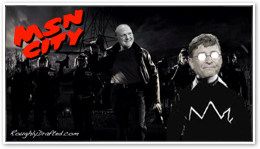

Recall how Microsoft developed its own version of MPEG-2 into the VC-1 codec, then worked to position it against the industry standard MPEG-4 H.264; or how it rivals the industry standard MP4 with its ASP media container in Windows Media.
Microsoft is also working to unseat JPEG graphics with its own format, and works to subvert any progress in the OpenDocument file format with its own complex and unwieldy Microsoft Office file types.
The Unwinnable War.
Rather than standing on the shoulders of Unix and working with the industry, Microsoft is entrenching to fight the rest of the world in an unwinnable war to establish its proprietary software and standards as the chains that bind the tech world for another decade.
Uninformed pundits like to portray Windows as a safe alternative to Linux in a world where ‘Unix is dying’ and Apple is stuck at an inconsequential 2% share of the entire world’s computers.
The reality is that Windows has lost the support of its former principle backers including IBM, and that Unix, Linux, and Mac OS X are all participants in the common, industry standard POSIX platform.
Anyone who describes Linux and Unix as entirely unrelated products in a fractured market where Windows is the only viable platform is either a Microsoft shill or is woefully ignorant. Key industry players are choosing to collectively back open, Unix-like systems because they are tired of paying a Microsoft premium for their software.
Software Sells Hardware.
In addition to the big Unix/Linux backers like IBM, Oracle, and Sun, emerging markets--in particular China--are also pushing for Linux, not necessarily because they believe in open source, but because they don't want to pay Microsoft for its software. That's why Microsoft is desperately trying to lowball its OS overseas.
That will leave Microsoft selling to the same market Apple targets: professionals and quality-conscious consumers. The difference is that Apple builds its own hardware. How long will HP and Dell continue to sell Vista as their high volume, low end consumers demand increasingly cheaper machines?
Microsoft has already proven that it cannot sell hardware. From the Xbox to the Zune, Microsoft's consumer and home entertainment products have generated well over $5 billion in losses, many times worse than Apple at its most beleaguered period in the mid 90s.
Microsoft is trying to sell software to a world that has discovered that software itself is a poor deal. Consumers want desirable, integrated products that work. Microsoft is skating along on fat profits from past deals, but the ice holding its business model up is getting increasingly thin.
Dell has already decided to go back to selling the 6 year old XP rather than trying to sell just the flashy, high priced Vista. That’s awfully bad news for an OS vendor that’s already under siege on two fronts in the OS war--with Linux on the server low end and Mac OS X on the desktop high end--and barely able to ship an update.
Leopard vs Copland/Vista.
Apple’s delay of Leopard isn't related to the systemic architectural problems that kept Copland from ever being released, or that forced Microsoft to repeatedly start over on in its efforts to deliver Vista.
In fact, Apple's statement pointedly said that the company would be shipping Leopard at WWDC as a feature complete beta. Feature complete means finished, not hung up on “sheesh how’s this going to work?” problems.
Apple’s not in the position of adding impossible new floors to the Pyramid. The floors are done, and Apple is postponing finishing work to focus its efforts on the iPhone rollout.
Apple’s Lean Operation.
The explanation that Apple is shifting its QA efforts into polishing the iPhone correlates with the company’s furious pace in releasing updates to Mac OS X since 2000, migrating the Mac to Intel, and branching out into new markets, from the iPods to Apple TV.
Leopard isn't unworkably hung up on barriers; Apple just runs a brutally lean operation. Compare Buzz Anderson's recent description of working at Apple.
The company delivers products using small teams. That results in better products, not the committee designed, auto-coded, and feature ridden tech products that spew from typical corporations.
The Mythical Man Month.
As anyone who has managed a complex product knows, simply adding new people to a project does not speed up development. Microsoft devoted huge resources to pushing out Vista, but still struggled for half a decade to get it finished.
One of Apple's unique keys to crafting good products is to painstakingly plan, competently execute, and then refine products down into highly specialized devices. A similar factor creates the quality difference between artisan wine and the stuff that ships in a cardboard box.
By shipping products when they're done, rather than dumping them out early and disappointing early adopters, Apple is building a reputation as a quality vendor.

The two or three week delay of the Apple TV was not an earth shattering problem. The longer postponement of Leopard is certainly more disappointing to customers anticipating its release, but it means that Apple is operating at the top of its game. It has never released as many new product directions as it did this year.
What about the strategic timing of Leopard? Will Leopard miss a magical window of opportunity left open by Vista's weak release? The next article in the series will take a look.
Like reading RoughlyDrafted? Share articles with your friends, link from your blog, and subscribe to my podcast!
Next Articles:
This Series

Haloscan Q107
Has Leopard Fallen into a Copland-Vista Conundrum?
Tuesday, April 24, 2007

Ad







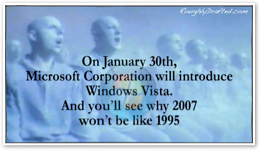
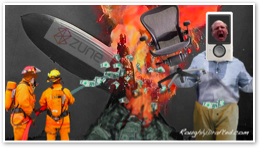
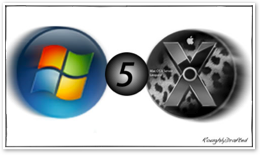

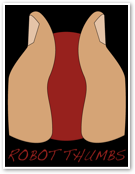
 Bookmark on Del.icio.us
Bookmark on Del.icio.us Discuss on Reddit
Discuss on Reddit Critically review on NewsTrust
Critically review on NewsTrust Forward to Friends
Forward to Friends
 Get RSS Feed
Get RSS Feed Download RSS Widget
Download RSS Widget





